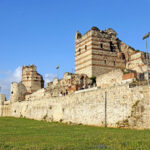Igneous rocks, born from fire as their Latin origin suggests, are created from the cooling and solidification of molten rock. This hot melt originates deep within the Earth, often in regions near active tectonic plate boundaries or above mantle plumes known as hot spots, before ascending towards the surface. Within the realm of igneous rocks, we distinguish between two primary categories based on their formation location: intrusive and extrusive. This discussion will focus on extrusive igneous rocks, exploring their formation process and typical locations.
Extrusive igneous rocks, also known as volcanic rocks, are formed when magma reaches the Earth’s surface and cools rapidly. This process typically occurs during volcanic eruptions or through fissures in the Earth’s crust. When molten rock erupts onto the surface, it is termed lava. The significant difference between extrusive and intrusive rocks lies in the cooling rate. Extrusive rocks are exposed to the much cooler atmosphere, or even water, at the Earth’s surface. This stark temperature contrast causes rapid cooling and solidification, happening almost instantaneously in geological terms.
Alt text: Fiery pahoehoe lava flow at night on Kilauea volcano, Hawaii, illustrating extrusive igneous rock formation.
The rapid cooling process has a profound impact on the texture of extrusive rocks. Unlike intrusive rocks that cool slowly beneath the surface and develop large, visible mineral grains, extrusive rocks experience minimal crystal growth time. This results in a characteristic fine-grained texture. In some cases, the cooling is so rapid that mineral crystals do not have time to form at all, leading to a glassy texture, as seen in obsidian.
Another distinctive feature of many extrusive rocks is their vesicular texture. As lava erupts, it often contains dissolved gases. The sudden drop in pressure as the lava reaches the surface allows these gases to escape, forming bubbles within the cooling rock. When the lava solidifies, these bubbles are trapped, leaving behind voids or vesicles. This process gives the rock a porous, sponge-like appearance.
Alt text: Vesicular basalt close-up showing numerous vesicles, evidence of gas bubbles trapped during extrusive rock formation.
Where are extrusive igneous rocks commonly found? As their volcanic name suggests, they are predominantly found in volcanic regions around the world. These areas include:
- Volcanoes: Extrusive rocks are the primary components of volcanoes. From the steep slopes of stratovolcanoes to the broad shields of shield volcanoes, these geological formations are built layer upon layer by successive eruptions of lava and volcanic ash, all of which solidify into extrusive igneous rocks.
- Mid-Ocean Ridges: These underwater mountain ranges are zones where tectonic plates are diverging, and magma from the Earth’s mantle rises to fill the gap. The lava erupted here cools quickly in the ocean water, forming basalt, a common type of extrusive rock that makes up a significant portion of the ocean floor.
- Continental Fissures: In some locations, vast fissures or cracks in the Earth’s continental crust allow magma to reach the surface without forming a central volcano. These fissures can produce extensive lava flows, covering large areas with extrusive rocks.
- Hot Spots: Locations like Hawaii and Iceland are volcanic hotspots where plumes of hot mantle material rise to the surface. These hotspots are characterized by ongoing volcanic activity and the formation of islands and seamounts composed of extrusive igneous rocks.
Examples of common extrusive igneous rocks include:
- Rhyolite: A light-colored volcanic rock, chemically equivalent to granite, often formed in continental volcanic settings.
- Andesite: An intermediate volcanic rock, common in volcanic arcs above subduction zones, often associated with explosive eruptions.
- Basalt: A dark-colored, fine-grained volcanic rock, the most common type of extrusive rock, forming much of the oceanic crust and also found in continental flood basalts.
- Obsidian: Volcanic glass, formed from extremely rapid cooling of viscous lava, resulting in a glassy texture and conchoidal fracture.
In conclusion, extrusive igneous rocks are formed when magma, known as lava once it reaches the surface, erupts from volcanoes or fissures and solidifies rapidly in the cooler environment at or near the Earth’s surface. This rapid cooling leads to their characteristic fine-grained or glassy textures and often vesicular nature. Found predominantly in volcanic regions, mid-ocean ridges, and areas with continental fissures and hotspots, extrusive rocks provide valuable insights into Earth’s dynamic geological processes and history.

